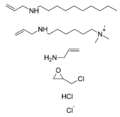Colesevelam
Information about Colesevelam[edit]
Colesevelam is a nonabsorbed bile acid sequestrant that is used a therapy of hyperlipidemia and for the pruritus of chronic liver disease and biliary obstruction. Colesevelam has not been associated with clinically apparent liver injury.
Mechanism of action of Colesevelam[edit]
Colesevelam (koe" le sev' e lam) is a large, highly positively charged anion exchange resin that binds to negatively charged anions such as bile acids (as well as other organic compounds and some medications). The binding of bile acids to colesevelam creates an insoluble compound that cannot be reabsorbed and is thus excreted in the feces. Bile acids ordinarily undergo extensive (>95%) enterohepatic recirculation, being secreted in bile, acting as fat solubilizing compounds in the upper intestine, and then being reabsorbed in the distal small bowel. Chronic loss of bile acids results in a contraction in the total bile acid pool. The liver compensates for this decrease by increasing bile acid synthesis, which directly competes with cholesterol synthesis resulting in a decrease in serum levels. Some of the decrease in serum cholesterol may also result from inhibition of fat absorption by the binding of bile acids to colesevelam. Colesevelam
FDA approval information for Colesevelam[edit]
Colesevelam was approved for use in the United States in 2000 and is currently used largely as an adjunctive therapy when statins or other lipid lowering agents result in an inadequate decrease in cholesterol levels. Colesevelam is also approved as an adjunct to diet and exercise to improve glycemic control in type 2 diabetes. Colesevelam is available in tablets of 625 mg under the brand name of Welchol. The usual dose is three tablets twice a day, given with meals or six tablets once daily. Other drugs should be given 1 hour before or 4 to 6 hours after colesevelam. Colesevelam is administered in tablet form and does not have the problem of lack of palatability that is characteristic of other bile acid resins.
Side effects of Colesevelam[edit]
Side effects include abdominal discomfort, indigestion, nausea, flatuence and constipation.
Lipid lowering medications
- Niacin (Nicotinic Acid)
- Miscellaneous
-
Structure of Colesevelam
-
Colesevelam
Ad. Transform your life with W8MD's Budget GLP-1 injections from $75


W8MD offers a medical weight loss program to lose weight in Philadelphia. Our physician-supervised medical weight loss provides:
- Weight loss injections in NYC (generic and brand names):
- Zepbound / Mounjaro, Wegovy / Ozempic, Saxenda
- Most insurances accepted or discounted self-pay rates. We will obtain insurance prior authorizations if needed.
- Generic GLP1 weight loss injections from $75 for the starting dose.
- Also offer prescription weight loss medications including Phentermine, Qsymia, Diethylpropion, Contrave etc.
NYC weight loss doctor appointmentsNYC weight loss doctor appointments
Start your NYC weight loss journey today at our NYC medical weight loss and Philadelphia medical weight loss clinics.
- Call 718-946-5500 to lose weight in NYC or for medical weight loss in Philadelphia 215-676-2334.
- Tags:NYC medical weight loss, Philadelphia lose weight Zepbound NYC, Budget GLP1 weight loss injections, Wegovy Philadelphia, Wegovy NYC, Philadelphia medical weight loss, Brookly weight loss and Wegovy NYC
|
WikiMD's Wellness Encyclopedia |
| Let Food Be Thy Medicine Medicine Thy Food - Hippocrates |
Medical Disclaimer: WikiMD is not a substitute for professional medical advice. The information on WikiMD is provided as an information resource only, may be incorrect, outdated or misleading, and is not to be used or relied on for any diagnostic or treatment purposes. Please consult your health care provider before making any healthcare decisions or for guidance about a specific medical condition. WikiMD expressly disclaims responsibility, and shall have no liability, for any damages, loss, injury, or liability whatsoever suffered as a result of your reliance on the information contained in this site. By visiting this site you agree to the foregoing terms and conditions, which may from time to time be changed or supplemented by WikiMD. If you do not agree to the foregoing terms and conditions, you should not enter or use this site. See full disclaimer.
Credits:Most images are courtesy of Wikimedia commons, and templates, categories Wikipedia, licensed under CC BY SA or similar.
Translate this page: - East Asian
中文,
日本,
한국어,
South Asian
हिन्दी,
தமிழ்,
తెలుగు,
Urdu,
ಕನ್ನಡ,
Southeast Asian
Indonesian,
Vietnamese,
Thai,
မြန်မာဘာသာ,
বাংলা
European
español,
Deutsch,
français,
Greek,
português do Brasil,
polski,
română,
русский,
Nederlands,
norsk,
svenska,
suomi,
Italian
Middle Eastern & African
عربى,
Turkish,
Persian,
Hebrew,
Afrikaans,
isiZulu,
Kiswahili,
Other
Bulgarian,
Hungarian,
Czech,
Swedish,
മലയാളം,
मराठी,
ਪੰਜਾਬੀ,
ગુજરાતી,
Portuguese,
Ukrainian

